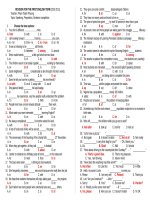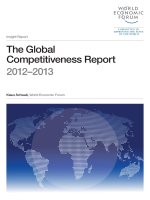Cracking the AP biology exam, 2012 editi princeton review
Bạn đang xem bản rút gọn của tài liệu. Xem và tải ngay bản đầy đủ của tài liệu tại đây (7.09 MB, 885 trang )
Editorial
Rob Franek, VP Test Prep Books, Publisher
Seamus Mullarkey, Associate Publisher
Laura Braswell, Senior Editor
Selena Coppock, Editor
Heather Brady, Editor
Random House Publishing Team
Tom Russell, Publisher
Nicole Benhabib, Publishing Manager
Ellen L. Reed, Production Manager
Alison Stoltzfus, Associate Managing Editor
The Princeton Review, Inc.
111 Speen Street, Suite 550
Framingham, MA 01701
E-mail:
The Princeton Review is not affiliated with Princeton University.
Copyright © 2011 by The Princeton Review, Inc.
Cover design © 2011 Random House, Inc.
Cover art © 2011 Wavebreak Media Ltd/Alamy
All rights reserved. Published in the United States by Random House, Inc., New York, and
in Canada by Random House of Canada Limited, Toronto.
eISBN: 978-0-307-94440-5
ISSN: 1092-0080
Editor: Kristen O’Toole
Production Editor: Michael Breslosky
2012 Edition
v3.1
ACKNOWLEDGMENTS
ACKNOWLEDGMENTS
Special thanks go to the sta of The Princeton Review.
Also, I would like to dedicate this book to my parents
who instilled in me a love for science.
Thanks also to Andrew Taggart for his work on this
edition of the book.
CONTENTS
Cover
Title Page
Copyright
Acknowledgments
INTRODUCTION
1
ORIENTATION
What Is the AP Biology Exam?
Who Writes the AP Biology Exam?
The Princeton Review Approach
How Much Biology Do You Need to Know?
The Structure of the Test
Using The Princeton Review Approach to Crack the System
Let’s Get Cracking!
2
THE CHEMISTRY OF LIFE
Elements
The Essential Elements of Life
Subatomic Particles
Compounds
Water: The Versatile Molecule
The Acid Test
Organic Molecules
The Heterotroph Hypothesis
Key Words
Chapter 2 Quiz
3
CELLS
Living Things
What Are the Different Types of Cells?
Key Words
Chapter 3 Quiz
4
CELLULAR ENERGETICS
Bioenergetics
Enzymes
Types of Reactions
Adenosine Triphosphate (ATP)
Aerobic Respiration
Chemiosmosis
Anaerobic Respiration
Key Words
Chapter 4 Quiz
5
PHOTOSYNTHESIS
The Anatomy of a Leaf
A Closer Look at Photosynthesis
Key Words
Chapter 5 Quiz
6
MOLECULAR GENETICS
DNA: The Blueprint of Life
The Molecular Structure of DNA
Why DNA Is Important
DNA Replication
RNA
Protein Synthesis
Mutations
Recombinant DNA
Biotechnology
Key Words
Chapter 6 Quiz
7
CELL REPRODUCTION
Cell Division
The Cell Cycle
Mitosis: The Dance of the Chromosomes
Haploids Versus Diploids
An Overview of Meiosis
A Closer Look at Meiosis
Key Words
Chapter 7 Quiz
8
HEREDITY
Gregor Mendel: The Father of Genetics
Mendelian Genetics
Beyond Mendelian Genetics
Sex-Linked Traits
Key Words
Chapter 8 Quiz
9
DIVERSITY OF ORGANISMS
Taxonomy
How Classification Works
I. Kingdom Archaebacteria
II. Kingdom Eubacteria
III. Kingdom Protista
IV. Kingdom Fungi
V. Kingdom Plantae
VI. Kingdom Animalia
Viruses
Key Words
Chapter 9 Quiz
10 PLANTS
Plant Classification
Life Cycle of Plants
Plant Growth
Special Structures in Plants
Tropical Tropisms
Key Words
Chapter 10 Quiz
11 ANIMAL STRUCTURE AND FUNCTION
I. The Digestive System
Key Words
Digestive System Quiz
II. The Respiratory System
Key Words
Respiratory System Quiz
III. The Circulatory System
Key Words
Circulatory System Quiz
IV. The Lymphatic and Immune System
Key Words
Lymphatic and Immune System Quiz
V. The Excretory System
Key Words
Excretory System Quiz
VI. The Nervous System
Key Words
Nervous System Quiz
VII. The Musculoskeletal System
Key Words
Musculoskeletal System Quiz
VIII. The Endocrine System
Key Words
Endocrine System Quiz
IX. The Reproductive System and Embryonic Development
Key Words
Key Words
Reproductive System and Embryonic Development Quiz
12 EVOLUTION
Natural Selection
Genetic Variability
Causes of Evolution
Species
Population Genetics
Key Words
Chapter 12 Quiz
13 ANIMAL BEHAVIOR AND ECOLOGY
Behavior
Instincts
Ecology
Population Ecology
Human Impact on the Environment
Key Words
Chapter 13 Quiz
14 THE FREE-RESPONSE QUESTIONS
The Essays
Grading Checklist
Sample Essays
How to Use Our Practice Essays
Sample Essay Questions
15 LABORATORY
Lab 1: Diffusion and Osmosis
Lab 2: Enzyme Catalysis
Lab 3: Mitosis and Meiosis
Lab 4: Plant Pigments and Photosynthesis
Lab 5: Cell Respiration
Lab 6: Molecular Biology
Lab 7: Genetics of Organisms
Lab 8: Population Genetics and Evolution
Lab 9: Transpiration
Lab 10: Physiology and the Circulatory System
Lab 11: Animal Behavior
Lab 12: Dissolved Oxygen and Aquatic Primary Productivity
16 ANSWERS AND EXPLANATIONS TO THE CHAPTER QUIZZES
17 THE PRINCETON REVIEW AP BIOLOGY PRACTICE TEST 1
Section I
Section II
18 ANSWERS AND EXPLANATIONS TO PRACTICE TEST 1
19 THE PRINCETON REVIEW AP BIOLOGY PRACTICE TEST 2
Section I
Section II
20 ANSWERS AND EXPLANATIONS TO PRACTICE TEST 2
Index
Introduction
WHAT IS THE PRINCETON
WHAT IS THE PRINCETON
REVIEW?
The Princeton Review is an international test-preparation
company with branches in all major U.S. cities and
several cities abroad. In 1981, John Katzman started
teaching an SAT prep course in his parents’ living room.
Within ve years, The Princeton Review had become the
largest SAT prep program in the country.
Our phenomenal success in improving students’ scores
on standardized tests is due to a simple, innovative, and
radically e ective philosophy: Study the test, not just
what the test claims to test. This approach has led to the
development of techniques for taking standardized tests
based on the principles the test writers themselves use to
write the tests.
The Princeton Review has found that its methods work
not just for cracking the SAT, but for any standardized
test. We’ve already successfully applied our system to the
GMAT, LSAT, MCAT, and GRE, to name just a few.
Obviously, you need to be well versed in biology to do
well on the AP Biology Exam, but you should remember
that any standardized test is partly a measure of your
ability to think like the people who write standardized
tests. This book will help you brush up on your AP
Biology and prepare for the exam using our time-tested
principle: Crack the system based on how the test is
created.
We also o er books and online services that cover an
enormous variety of education and career-related topics.
If you’re interested, check out our website at
PrincetonReview.com.
1
Orientation
WHAT IS THE AP BIOLOGY
WHAT IS THE AP BIOLOGY
EXAM?
So you’ve just spent the better part of a year in an
advanced placement biology course. And what have you
learned? Biology, sure. But what kind of biology?
In theory, you’re midway through the equivalent of a
college-level biology course. However, high school
courses vary, to say the least. Sometimes you get a great
teacher, sometimes … you don’t. The Advanced
Placement Biology Exam is a way to determine if the
course you’ve taken is up to par: Have you really learned
a year’s worth of college-level biology?
That’s what the AP test is intended to measure. You
take it so that colleges can determine if you’ve mastered
the material that the average college freshman learns in
his or her introductory biology course. If so, you’ll be
eligible for college credit, advanced standing, or both,
depending on the college. Di erent colleges have
di erent policies, so make sure you nd out from the
colleges you intend to apply to exactly what their
policies are.
What if you’re not enrolled in an AP course? Provided
you’ve seen the same topics as those who are enrolled in
such a course, there’s no reason why you shouldn’t
consider taking the AP Biology Exam. However, before
you sign up, check with your biology teacher. He or she
is in a much better position to determine if you’ve
actually done college-level science this past year.
WHO WRITES THE AP BIOLOGY
EXAM?
The AP Biology Exam is written by ETS, the Educational
Testing Service. These are the same folks who bring you
all your standardized tests, from the PSAT and the SAT to
the rest of your AP subject tests. How do they go about
it?
A committee of university and high school teachers,
along with ETS, determines the content and format of the
AP exam. Why should you care about ETS? Well, you
shouldn’t. But you should care about how they write the
test, which is extremely important when it comes to our
approach.
THE PRINCETON REVIEW
APPROACH
There are basically two ways to prepare for the AP
Biology Exam:
Know absolutely everything about everything. This
is ETS’s way. Bad idea.
Review only what you need to know, and tackle
the test strategically. This is The Princeton Review’s
way—and the best way to improve your score.
Rather than trying to teach you everything there is to
know about biology, we at The Princeton Review focus
on test-taking strategies. Naturally, we’ll review some
hard science as well. But rather than getting bogged
down in the details, we’ll focus on the biology you need
to know for the test, explaining and highlighting key
concepts along the way. But who are we and how do we
know so much about what’s important for the AP
Biology Exam?
The Princeton Review is the nation’s fastest growing
test preparation company. We’ve been at it for more
than 25 years, preparing students for standardized tests
by showing them how to beat ETS at its own game. Our
insight into the AP Biology Exam is the fruit of intensive
analysis of heaps of AP exams. For you, this translates
into a relatively painless, sure- re approach to bee ng
up your AP score.
In this book, we’ll show you how best to take the AP
Biology Exam because we know exactly how it’s put
together. By understanding how the test is written, we’ll
be able to help you outfox the test writers in three ways:
by reviewing only the biology you need to know
for the test
by giving you simple, straightforward strategies for
answering multiple-choice questions and for
writing essays
by focusing on the recurring themes for the AP
Biology Exam
By the time you nish this book, you’ll have both the
science and the strategies you’ll need to beat the AP
Biology Exam.
HOW MUCH BIOLOGY DO YOU
NEED TO KNOW?
Fortunately, we’ve already done the groundwork for you.
We know exactly what ETS likes to test and how it tests
it. The College Board, which administers the test, has put
together a list of the topics covered on the AP Biology
Exam, as well as a breakdown of the frequency with
which they appear on the test.
The AP Biology Exam covers three major areas:
Molecules and Cells
Heredity and Evolution
Organisms and Populations
These three areas are further subdivided into major
topics. By the way, the percentages given below will give
you a rough idea of the percentage of questions from
each category that will appear on the test. For instance,
since 10 percent of the test concerns cells (see below),
you can expect that about 10 percent of the multiplechoice questions—10 questions altogether—will deal
with cells.
Here, then, is the breakdown:
1. Molecules and Cells (25%)
A. Chemistry of Life (7%)
• Organic molecules in organisms
• Water
• Free-energy changes
• Enzymes
B. Cells (10%)
• Prokaryotic and eukaryotic cells
• Membranes
• Subcellular organization
• Cell cycle and its regulation
C. Cellular Energetics (8%)
• Coupled reactions
• Fermentation and cellular respiration
• Photosynthesis
2. Heredity and Evolution (25%)
A. Heredity (8%)
• Meiosis and gametogenesis
• Eukaryotic chromosomes
• Inheritance patterns
B. Molecular Genetics (9%)
• RNA and DNA structure and function
• Gene regulation
• Mutation
• Viral structure and replication
• Nucleic acid technology and applications
C. Evolutionary Biology (8%)
• Early evolution of life
• Evidence for evolution
• Mechanism of evolution
3. Organisms and Populations (50%)
A. Diversity of Organisms (8%)
• Evolutionary patterns
• Survey of the diversity of life
• Phylogenetic classification
• Evolutionary relationships
B. Structure and Function of Plants and Animals (32%)
• Reproduction, growth, and development
• Structural, physiological, and behavioral adaptation
• Response to the environment
C. Ecology (10%)
• Population dynamics
• Communities and ecosystems
• Global issues
In addition to the outline above, we have recently seen
a few minor content-related adjustments to the
examination. Although we have already included the
following content in our comprehensive subject review,
it has not previously been seen in questions on the AP
Biology Exam. You may now see questions requiring
familiarity with representative organisms from the three
domains: Bacteria, Archaea, and Eukarya. In addition,
more emphasis may be placed on identifying the
distinguishing characteristics of each group of
phylogenetic classi cation (domains, kingdoms, and the
major phyla and divisions of animals and plants). Other
than these minor updates to material tested, there are no
major changes in the overall concepts. Furthermore, the
distribution of questions relating to each of the topics
taught in the course also remains unaffected.
This might seem like an awful lot of information. But
for each topic, there are just a few key facts you’ll need
to know. Your biology textbooks may go into far greater
detail about some of these topics than we do. That’s
because they’re trying to teach you “correct science,”
whereas we’re aiming to improve your scores. Our
science is perfectly sound, it’s just cut down to size.
We’ve focused on crucial details and given you only
what’s important. Moreover, as you’ll soon see, our
treatment of these topics is far easier to handle.
THE STRUCTURE OF THE TEST
The AP Biology Exam is three hours long and is divided
into two sections: Section I (multiple-choice questions)
and Section II (free-response questions).
Section I consists of 100 multiple-choice questions.
These are further broken down into three parts: (1)
regular multiple-choice questions, (2) matching
questions, and (3) questions dealing with experiments or
data. ETS gives you 80 minutes to answer all 100 of
these questions.
Section II involves free-response questions. You’ll be
presented with four free-response questions touching
upon key issues in biology. You’re given a 10-minute
reading period followed by 90 minutes to answer all
four free-response questions.
If you’re thinking that this sounds like a heap of work
to try to nish in three hours, you’re absolutely right.
Here’s how it breaks down: You have roughly 45 seconds
per multiple-choice question and 22 minutes per freeresponse question. Gulp. How can you possibly tackle so
much science in so little time?
Fortunately, there’s absolutely no need to. As you’ll
soon see, we’re going to ask you to leave a small chunk
of the test blank. Which part? The parts you don’t like.
This selective approach to the test, which we call
“pacing,” is probably the most important part of our
overall strategy. But before we talk strategy, let’s look at
the di erent types of questions in the rst section of the
test.
SECTION I
There are basically three parts to the first section:
Part 1—contains regular multiple-choice questions
Part 2—is made up of matching questions
Part 3—consists of multiple-choice questions
dealing with an experiment or a set of data
Part 1
Part 1 of the AP Biology Exam consists of about 58 runof-the-mill multiple-choice questions. These questions
test your grasp of the fundamentals of biology (or so ETS
likes to think). Here’s an example:
22. If a segment of DNA reads 5´-ATG-CCA-GCT-3´, the
mRNA strand that results from the transcription of this
segment will be
(A) 3´-TAC-GGT-CGA-5´
(B) 3´-UAC-AGT-CAA-5´
(C) 3´-TAA-GGU-CGA-5´
(D) 3´-TAC-GGT-CTA-5´
(E) 3´-UAC-GGU-CGA-5´
Don’t worry about the answer to this question for now.
By the end of this book, it will be a piece of cake. The
majority of the questions in part 1 are presented in this
format. A few questions may include a gure, a diagram,
or a chart.
Part 2









